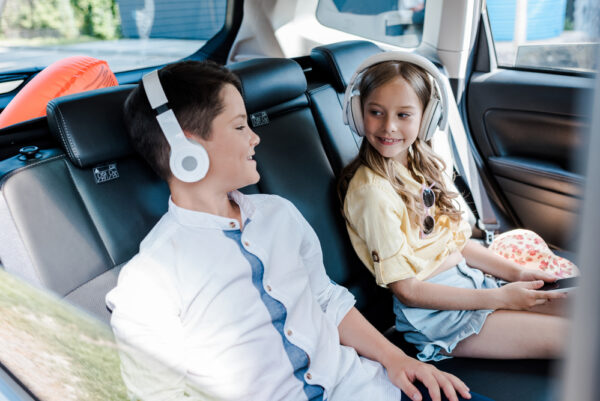Wireless headphones have become increasingly popular in recent years, allowing users to enjoy their favorite tunes without being tethered to their devices. And they are an excellent item to pack with you on vacation – for use on the plane, on a ship, on a beach, or anywhere else you want to listen to something privately!

But how do wireless headphones work? We all probably know that something called “Bluetooth” is involved.
Bluetooth technology uses low-powered radio waves to send and receive data between devices. When it comes to wireless headphones, Bluetooth transmits the audio signal from a smartphone or other device to the wireless headphones. The headphones then use an integrated radio receiver to receive and convert the audio signals into sound information your ears will recognize.
While the process may seem complicated, wireless headphones are pretty simple. Keep reading to learn more details on how they actually work.
Wireless Headphones Basics
People who have them love wireless headphones because of their convenience and portability. They allow users to listen to music, make phone calls, and watch videos without being tethered to their devices. Here are the basics of wireless headphones, including Bluetooth technology, wireless range, and battery life.
Bluetooth Technology
Most wireless headphones use Bluetooth technology to connect to devices such as smartphones, tablets, and computers. Bluetooth is a wireless communication standard that uses radio waves to transmit data over short distances. It allows devices to connect and share information quickly and easily without cables or wires.
When you pair wireless headphones to a device, the headphones and device establish a secure wireless connection. The device sends audio signals to the headphones, which convert the signals into sound waves that the user can hear. This technology also allows you to control playback, adjust volume, and answer phone calls directly from your headphones (when that feature is available).
Wireless Range
The wireless range of wireless headphones varies depending on the model and manufacturer. Most wireless headphones have a range of 30 feet or less, which means that the user must stay within this distance from the transmitting device to maintain a stable connection. However, some high-end models can have a range of up to 100 feet.
It is important to note that obstacles such as walls and other electronic devices can affect the wireless range. Users may experience drops in connection or interference if they move too far away from their device or encounter obstacles that block the signal.
Battery Life
Wireless headphones are powered by rechargeable batteries that provide hours of listening time. The battery life varies depending on the model and usage patterns. Most wireless headphones have a battery life of 5-10 hours, although some models can last up to 20 hours or more. This ability for longer battery life used to be found only in “high-end” models, but it is now becoming more common.
Users charge their wireless headphones using a USB cable that connects to a power source such as a computer or wall adapter. Some wireless headphones also come with a charging case that provides additional battery life and protection for the headphones when not in use. (These are usually the earbud format.)

How Do Wireless Headphones Work: Components
These are the essential components of wireless headphones and how they work together to produce sound.
Transmitter and Receiver
Wireless headphones usually need two things to work. One is the headphone, and the other is its transmitter. The transmitter in devices like smartphones, TVs, and speakers, usually comes in the form of a tiny chip that has Bluetooth radio and the required software for pairing with other Bluetooth-enabled devices.
When a user pairs their headphones with a device, the transmitter sends a signal to the headphones, telling them to start playing audio. This signal is sent through radio waves, a type of electromagnetic radiation that can travel through the air. The headphones then receive the signal and use it to play the audio.
Codec
The codec is a piece of software that compresses and decompresses audio files. It is responsible for converting the digital audio signal into an analog signal that the headphones can play. This software also ensures that the audio quality is maintained during transmission.
There are several types of this software used for wireless headphones, including SBC, AAC, and aptX. The codec that is used depends on the device and the headphones. Some types are better at maintaining audio quality than others, so choose headphones that support a high-quality codec if you want the best sound.
Drivers
The drivers are the speakers inside the headphones that produce the sound. They convert the electrical signal from the codec into sound waves that your ears can hear. The drivers’ size and quality can affect the headphones’ sound quality.
Wireless headphones can have either dynamic drivers or balanced armature drivers. Dynamic drivers are more common and produce a fuller sound. In contrast, balanced armature drivers are smaller and produce a more precise sound.
Putting It All Together
Overall, wireless headphones use a transmitter to send audio signals to the headphones, a codec to compress and decompress the audio, and drivers to produce the sound. By focusing on these key components, you can choose headphones that provide the best sound quality for your needs.

How Do Wireless Headphones Work: The Types
Wireless headphones come in various styles and types, each with advantages and disadvantages. Let’s discuss the three most common types of wireless headphones:
In-ear Headphones
In-ear headphones, also known as earbuds, are small and lightweight, making them ideal for people always on the go. They (are supposed to) fit snugly into the ear canal and are held in place by soft silicone or foam tips. In-ear headphones work well for people who want to listen to music or take phone calls while exercising or commuting. They are also popular among travelers because they are compact and easy to pack. You can literally just slide them into your pocket.

One disadvantage of in-ear headphones is that they can be uncomfortable for some people, especially if worn for extended periods. They can also be prone to falling out, especially during vigorous activities. They are also usually not the best choice of headphones for toddlers and small kids.
Over-ear Headphones
Over-ear headphones, or circumaural headphones, have large ear cups that completely cover the ears. They are known for their excellent sound quality and noise isolation. Over-ear headphones are ideal for people who want to immerse themselves in music or movies without being disturbed by external noise. They are also comfortable to wear for extended periods, making them ideal for long flights.
One disadvantage of over-ear headphones, however, is that some models can be bulky and heavy, making them less portable than other types of headphones. Some of them can also be hot and sweaty to wear during warm weather.
On-ear Headphones
On-ear headphones, also known as supra-aural headphones, have smaller ear cups that rest on the ears. They are lighter and more portable than over-ear headphones, making them ideal for people who want good sound quality without sacrificing portability. On-ear headphones are also more breathable than over-ear headphones, making them ideal for warm weather.
One disadvantage of on-ear headphones is that they can be less comfortable than over-ear headphones, especially if worn for extended periods. They can also be ineffective at noise isolation, allowing external noise to seep in easily.
Advantages of Wireless Headphones
Why folks love their wireless headphones!
Freedom of Movement
One of the most significant advantages of wireless headphones is the freedom of movement they offer. Users can move around without worrying about accidentally yanking the cord or getting tangled up. This is especially beneficial for those who like to listen to music while working out or doing other physical activities.
Wireless headphones also allow users to move around the room or house while still listening to music. Some wireless headphones offer up to 100ft distance from the audio source, allowing users to move around without carrying the audio source with them all the time.
No More Tangled Wires
Another advantage is the absence of tangled wires. With wired headphones, users often have to deal with the cord getting tangled or caught on something, which can be frustrating and time-consuming to untangle. Wireless headphones eliminate this problem, making them more convenient and user-friendly.
Improved Sound Quality
Wireless headphones have come a long way in terms of sound quality. While early models suffered from static and stuttering, today’s wireless headphones offer excellent sound quality and connection stability. They also offer noise-cancellation features, which can block out background noise and provide a more immersive listening experience. This can particularly be a big benefit when traveling if you want to block out the busy noise around you.
Moreover, wireless headphones offer some unique features that wired headphones do not, such as touch controls, voice commands, and the ability to connect to multiple devices simultaneously.
Disadvantages of Wireless Headphones
While wireless headphones offer many advantages over their wired counterparts, they also have some disadvantages. Here are some of the most common drawbacks:
Battery Life
One of the most significant disadvantages of wireless headphones is that they require a battery to function. No way around that! The model’s battery life can vary from a few hours to several days. This means that users must keep their headphones charged to ensure they don’t run out of power at an inconvenient time. In addition, the battery life of wireless headphones tends to degrade over time.
Latency
Wireless headphones can also suffer from latency issues. Latency refers to the delay between the time the audio signal is transmitted and the time it reaches the headphones. This delay can be noticeable when watching videos or playing games, where the audio needs to be synchronized with the video. Some wireless headphones have a latency of a few milliseconds, while others can have a delay of several hundred milliseconds. This can be a significant issue for users who are sensitive to audio delay.
Compatibility Issues
Wireless headphones can also suffer from compatibility issues. While most modern devices support Bluetooth, not all devices are compatible with all Bluetooth headphones. Some headphones may only work with specific devices or operating systems, which can be problematic for users with multiple devices. In addition, some wireless headphones may not work well with certain apps or software, which can limit their functionality.
Closing Thoughts
You don’t have to be a tech person to recognize that wireless headphones are a great asset for any traveler! But, with some basic information on how they work, you can make better decisions on picking the ones that are best for you.
